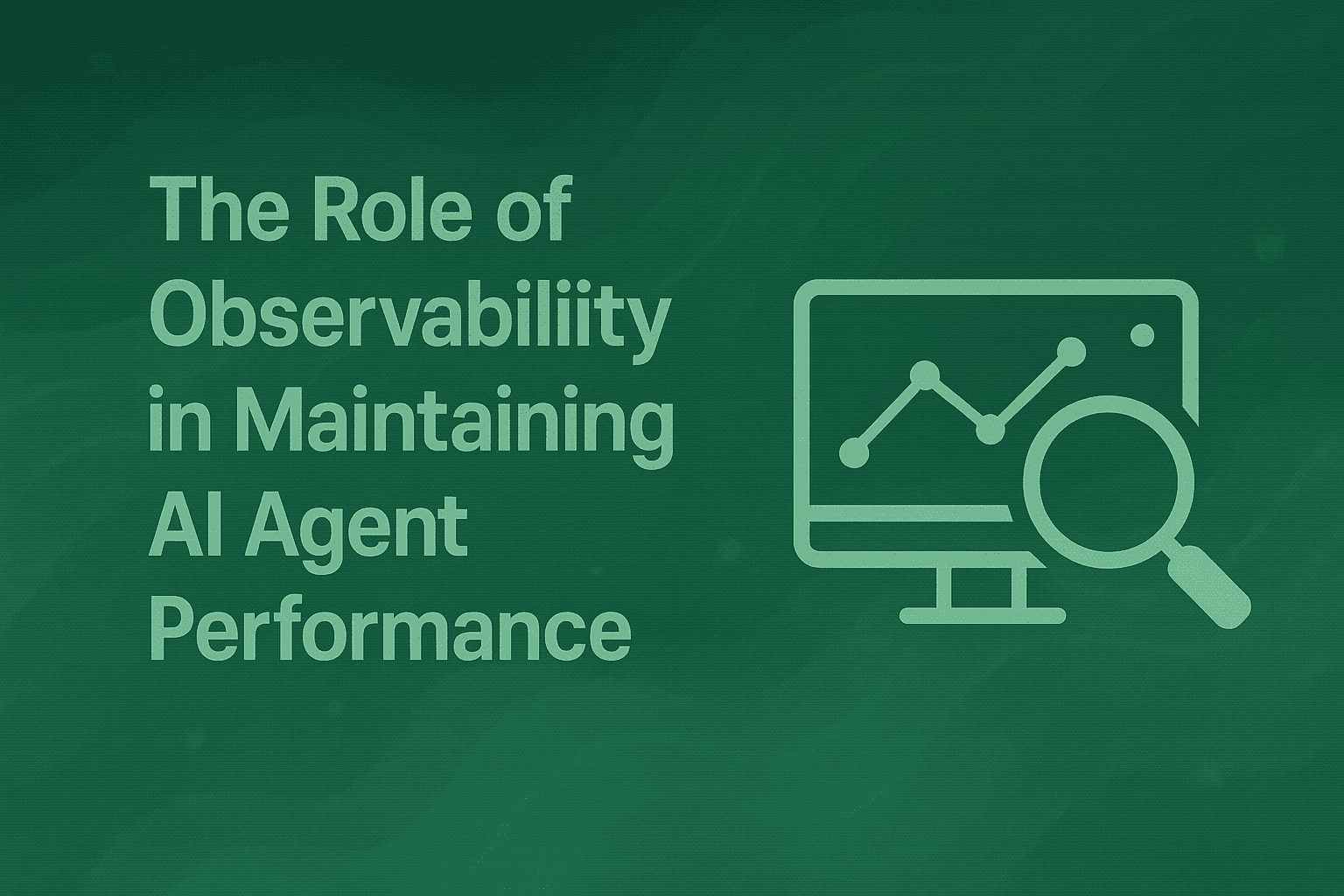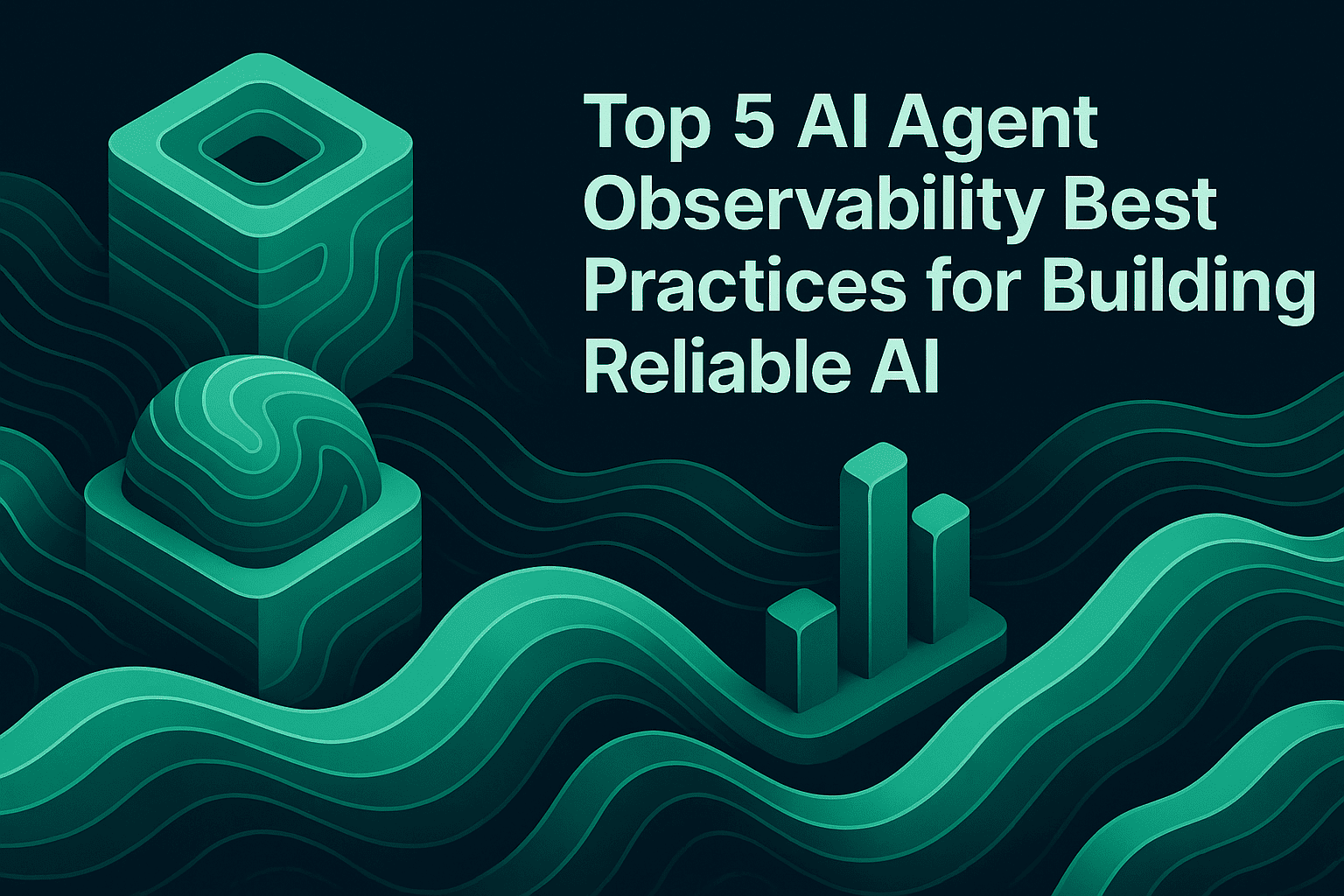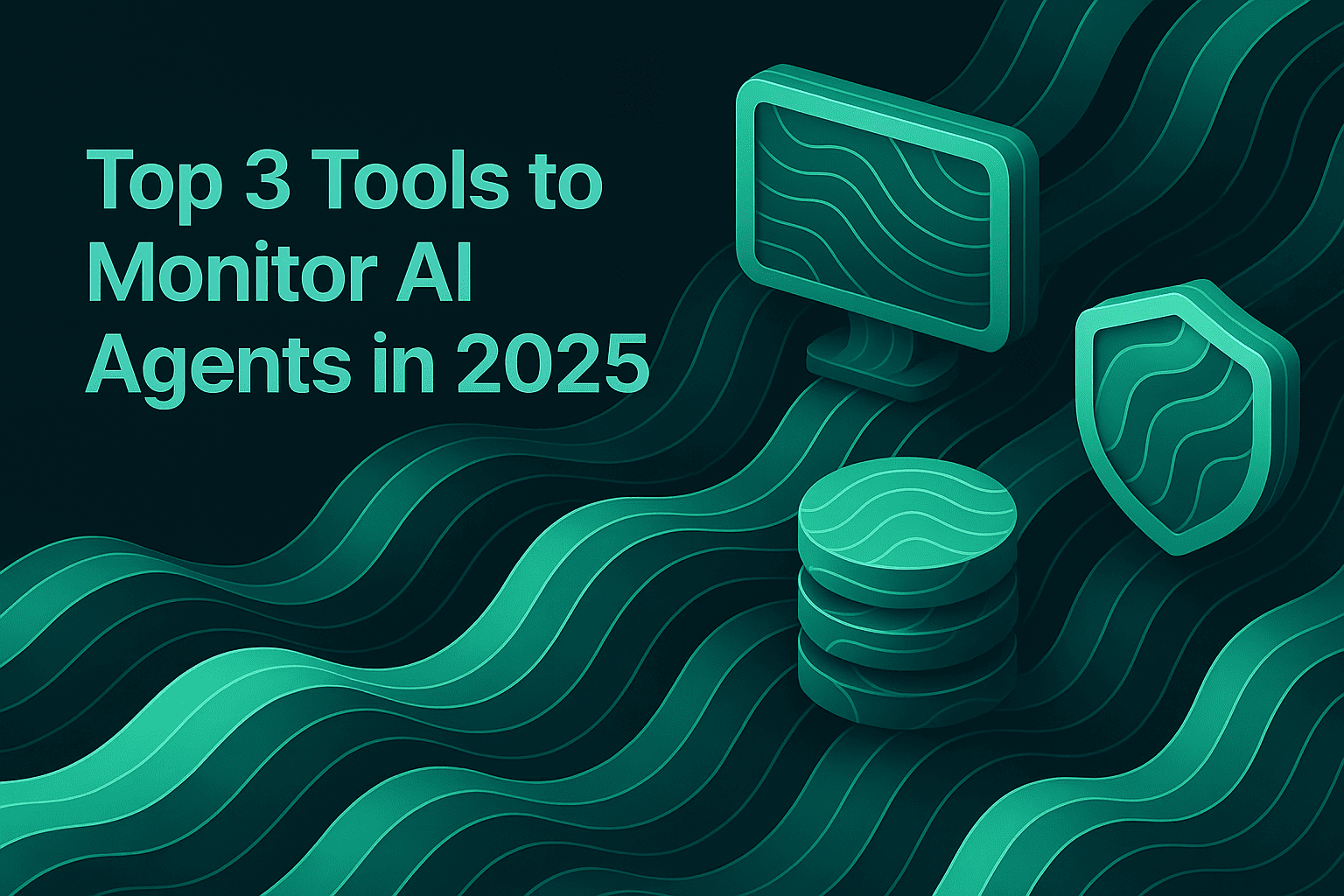Top 5 Tools for AI Agent Observability in 2025
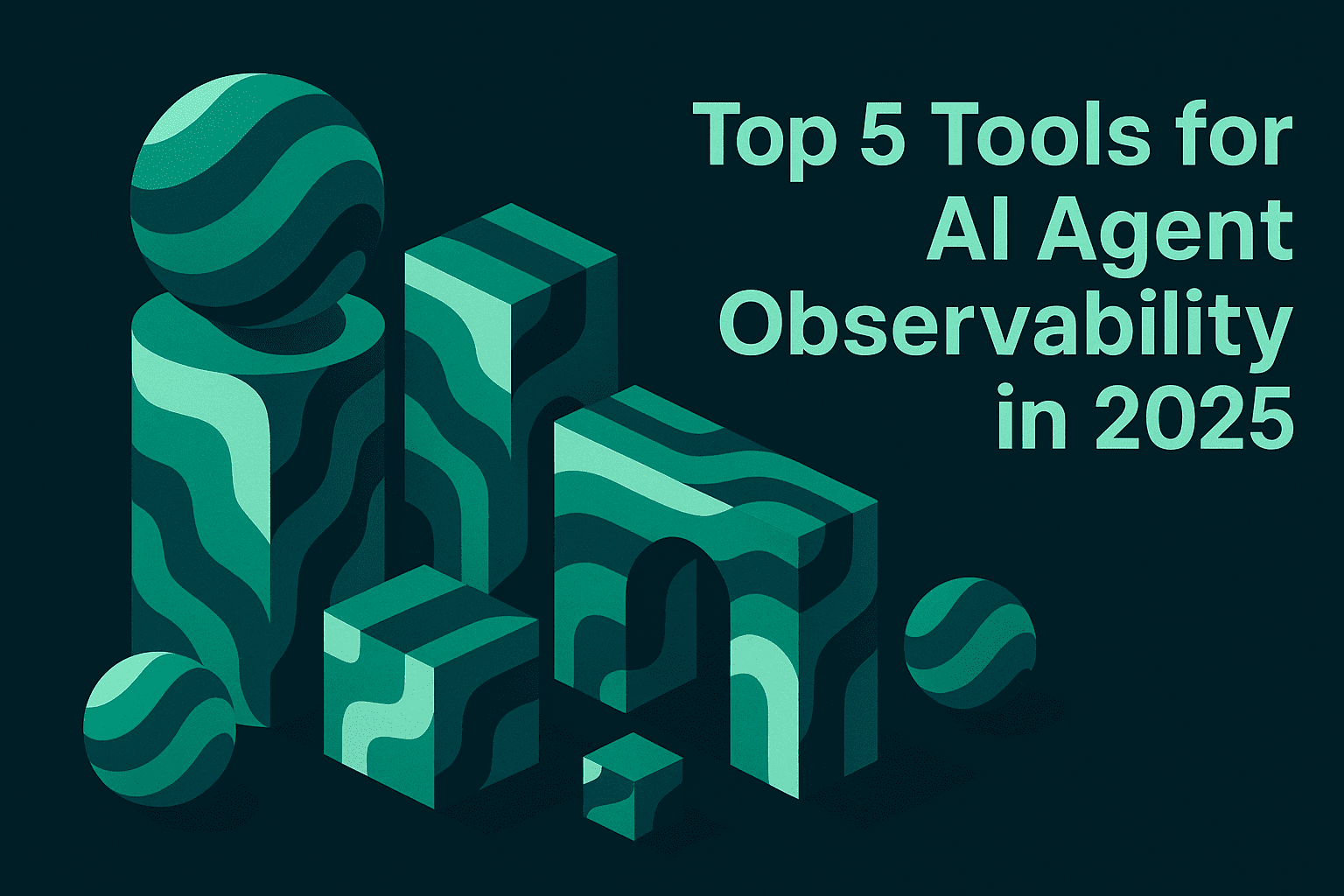
TL;DR
- Maxim AI: End-to-end platform for simulations, evals, and observability; built for cross-functional teams. Maxim AI
- LangSmith: Tracing, evals, and prompt iteration; works with or without LangChain. LangSmith
- Arize: Enterprise-grade evaluation and OTEL-powered tracing with online evals and dashboards. Arize platform
- Langfuse: Open-source LLM observability with multi-modal tracing and cost tracking. Langfuse
- Comet Opik: Open-source platform for logging, viewing, and evaluating LLM traces during dev and production. Opik
What AI Observability Is and Why It Matters in 2025
AI observability provides end-to-end visibility into agent behavior, spanning prompts, tool calls, retrievals, and multi-turn sessions. In 2025, teams rely on observability to maintain AI reliability across complex stacks and non-deterministic workflows. Platforms that support distributed tracing, online evaluations, and cross-team collaboration help catch regressions early and ship trustworthy AI faster.
Why AI observability is needed
•Non‑determinism: LLMs vary run‑to‑run. Distributed tracing across traces, spans, generations, tool calls, retrievals, and sessions turns opaque behavior into explainable execution paths.
• Production reliability: Observability catches regressions early via online evaluations, alerts, and dashboards tracking latency, error rate, and quality scores. Weekly reports and saved views help teams see trends.
• Cost and performance control: Token usage and per‑trace cost attribution surface expensive prompts, slow tools, and inefficient RAG. Optimizing with this visibility reduces spend without sacrificing quality.
• Tooling and integrations: OTEL/OTLP support routes the same traces to Maxim and existing collectors (Snowflake/New Relic) for unified ops, without dual instrumentation.
• Human feedback loops: Structured user ratings complement automated evals to align agents with real user preferences and drive prompt/version decisions.
• Governance and safety: Subjective metrics, guardrails, and alerts help detect toxicity, jailbreaks, or policy violations before users are impacted.
• Team velocity: Shared saved views, annotations, and eval dashboards shorten MTTR, speed prompt iteration, and align PMs, engineers, and reviewers on evidence.
• Enterprise readiness: RBAC, SSO, In‑VPC deployment, and SOC 2 ensure trace data stays compliant while enabling deep analysis.
Key Features for AI Agent Observability
- Distributed tracing: Capture traces, spans, generations, tool calls, and retrievals to debug complex flows. Tracing overview
- Drift and quality metrics: Track mean scores, pass rates, latency, and error rates over time via dashboards and reports. Tracing concepts
- Cost and latency tracking: Attribute tokens, cost, and timing at trace and span levels for optimization. Dashboard guide
- Online evaluations: Score real-world interactions continuously, trigger alerts, and gate deployments. Online evaluations overview
- User feedback: Collect structured ratings and comments to align agents with human preference. User feedback
- Real-time alerts: Notify Slack/PagerDuty/OpsGenie on thresholds for latency, cost, or evaluation regressions. Set up alerts
- Collaboration and saved views: Share filters and views for faster debugging across product and engineering. Saved views
- Flexible evals and datasets: Combine AI-as-judge, programmatic, and human evaluators at session/trace/span granularity. Library concepts
The Best Tools for Agent Observability
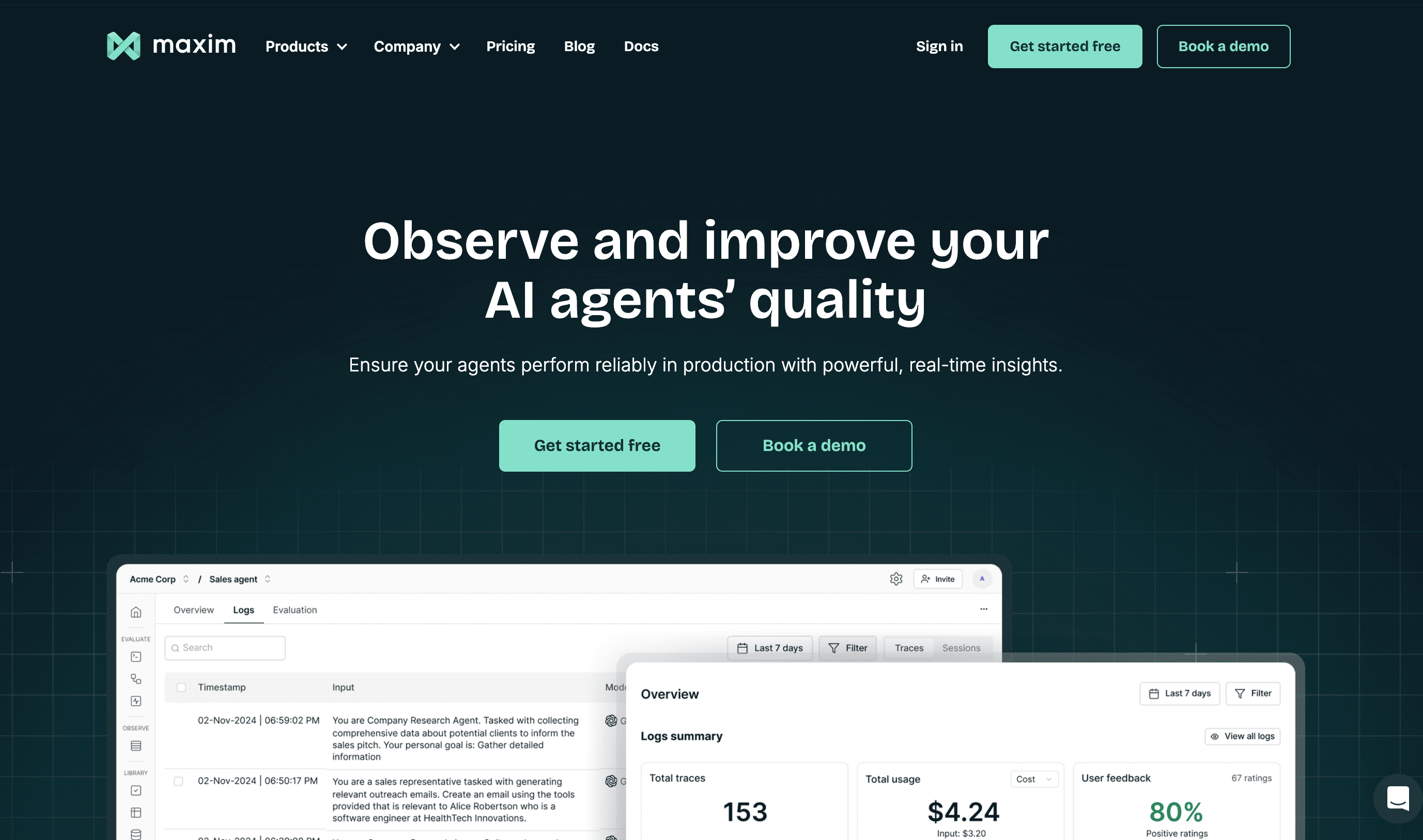
Maxim AI is an end-to-end evaluation and observability platform focused on agent quality across development and production. It combines Playground++ (prompt engineering), AI-powered simulations, unified evals (LLM-as-judge, programmatic, human), and real-time observability into one system. Teams ship agents reliably and more than 5x faster with cross-functional workflows spanning engineering and product. Maxim AI
- Key features:
- Comprehensive distributed tracing : for LLM apps with traces, spans, generations, retrieval, tool calls, events, sessions, tags, metadata, and errors for easy anomaly/drift detection, RCS and quick debugging. Tracing concepts
- Online evaluations: with alerting and reporting to monitor production quality. Reporting
- Data engine : for curation, multi-modal datasets, and continuous improvement from production logs. Platform overview
- OTLP ingestion + connectors: to forward traces to Snowflake/New Relic/OTEL collectors with enriched AI context. OTLP ingestion, Data connectors
- Saved views and custom dashboards: to accelerate debugging and share insights. Dashboard
- Agent Simulation: to simulate at scale across thousands of real-world scenarios and personas and capture detailed traces across tools, LLM calls, state transitions, etc and identify failure modes before releasing to production.
- Flexi evals: while SDKs allow evals to be run at any level of granularity for multi-agent systems, as shown here, from the UI teams could configure evaluations with fine-grained flexibility
- User experience and cross-functional collaboration: delivers highly performant SDKs in Python, TypeScript, Java, and Go. At the same time, the user experience is designed so that product teams can manage the AI lifecycle without writing code, reducing dependence on engineering.
- Best for:
- Teams needing a single platform for production grade end-to-end simulation, evals, and observability with enterprise-grade tracing, online evals, and data curation.
- Additional sources:
- Product pages: Agent observability, Agent simulation & evaluation, Experimentation
- Docs: Tracing overview, Generations, Tool calls
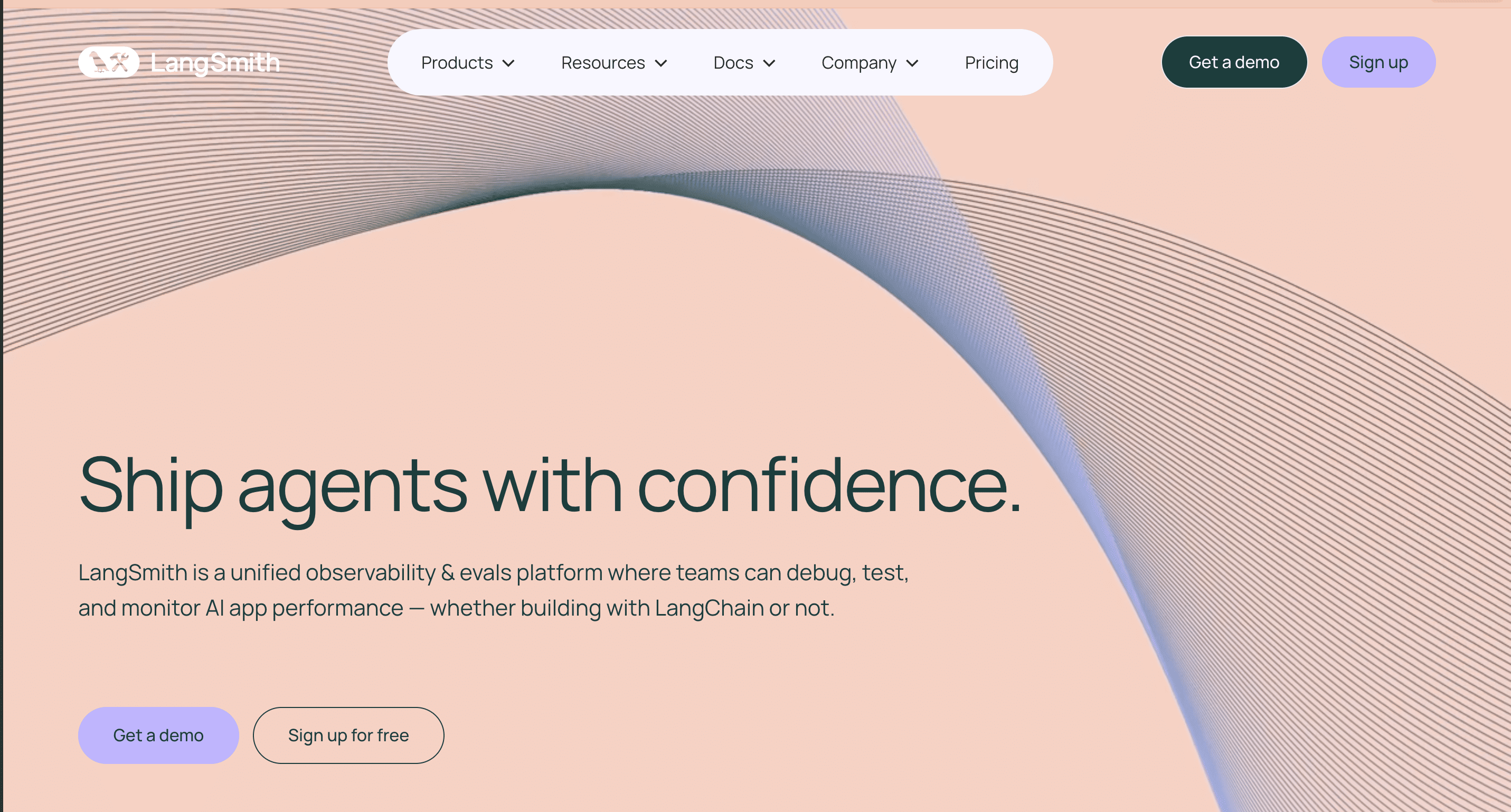
LangSmith provides unified observability and evals for AI applications built with LangChain or LangGraph. It offers detailed tracing to debug non-deterministic agent behavior, dashboards for cost/latency/quality, and workflows for turning production traces into datasets for evals. It supports OTEL-compliant logging, hybrid or self-hosted deployments, and collaboration on prompts. LangSmith
- Key features:
- OTEL-compliant: to integrate with existing monitoring solutions.
- Evals with LLM-as-Judge and human feedback
- Prompt playground and versioning: to iterate and compare outputs.
- Best for:
- Teams already using LangChain or seeking flexible tracing and evals with prompt iteration capabilities.
- Additional sources:
- Overview: LangSmith landing
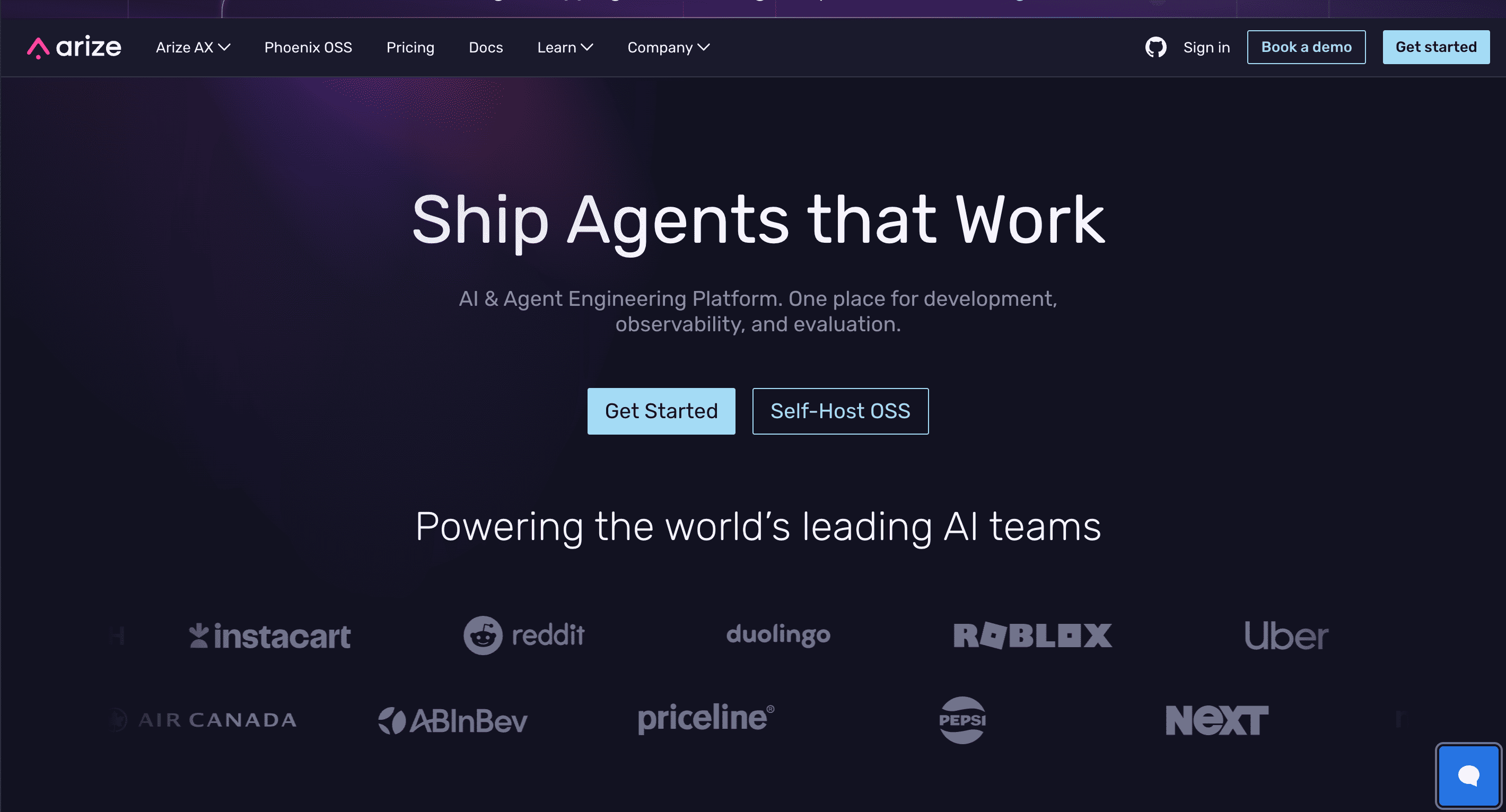
Arize is an AI engineering platform for development, observability, and evaluation. It provides ML observability, drift detection, evaluation tools for model monitoring in production. It offers strong visualization tools and integrates with various MLOps pipelines.Arize AI
- Features:
- Open standard tracing (OTEL) and online evals: to catch issues instantly.
- Monitoring and dashboards: with custom analytics and cost tracking.
- LLM-as-a-Judge: and CI/CD experiments.
- Real-time model drift
- data quality monitoring
- Integration: with major cloud and data platforms
- Best for:
- Enterprises with ML infrastructure seeking for ML monitoring.
- Additional sources:
- Quickstart: Tracing setup
- Product: LLM Observability & Evaluation Platform
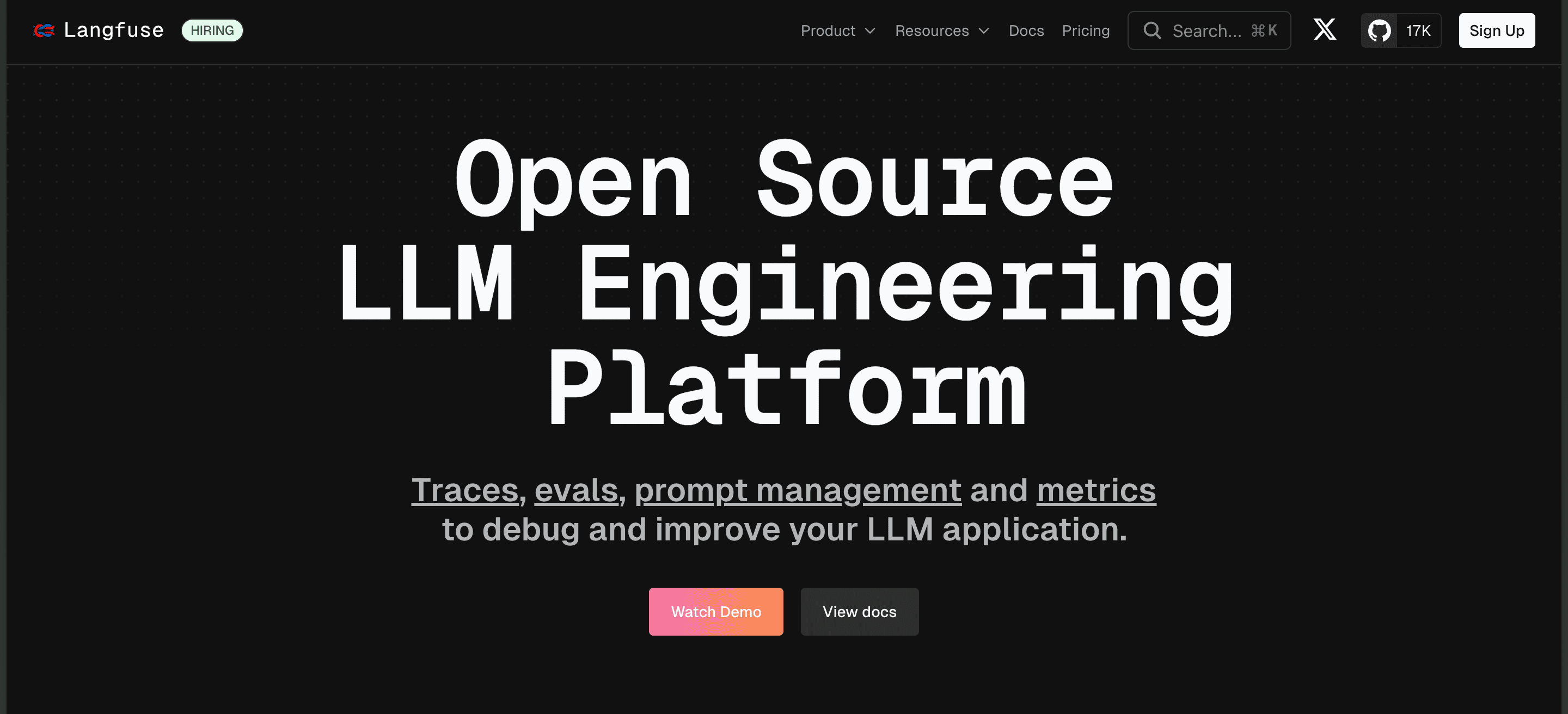
Langfuse is an open-source platform for observability and tracing of LLM applications. It captures inputs, outputs, tool usage, retries, latencies, and costs across multi-modal and multi-model stacks. It is framework and language agnostic, supporting Python and JavaScript SDKs.
- Features:
- Comprehensive tracing: Visualize and debug LLM calls, prompt chains, and tool usage.
- Open-source and self-hostable: Full control over deployment, data, and integrations.
- Evaluation framework: Supports custom evaluators and prompt management.
- Human annotation queues: Built-in support for human review.
- Best for:
- Teams prioritizing open-source, customizability, and self-hosting, with strong developer resources. Langfuse is particularly popular with organizations building their own LLMOps pipelines and needing full-stack control.
- Additional sources:
- Getting started: Start tracing
- Overview: Langfuse Overview
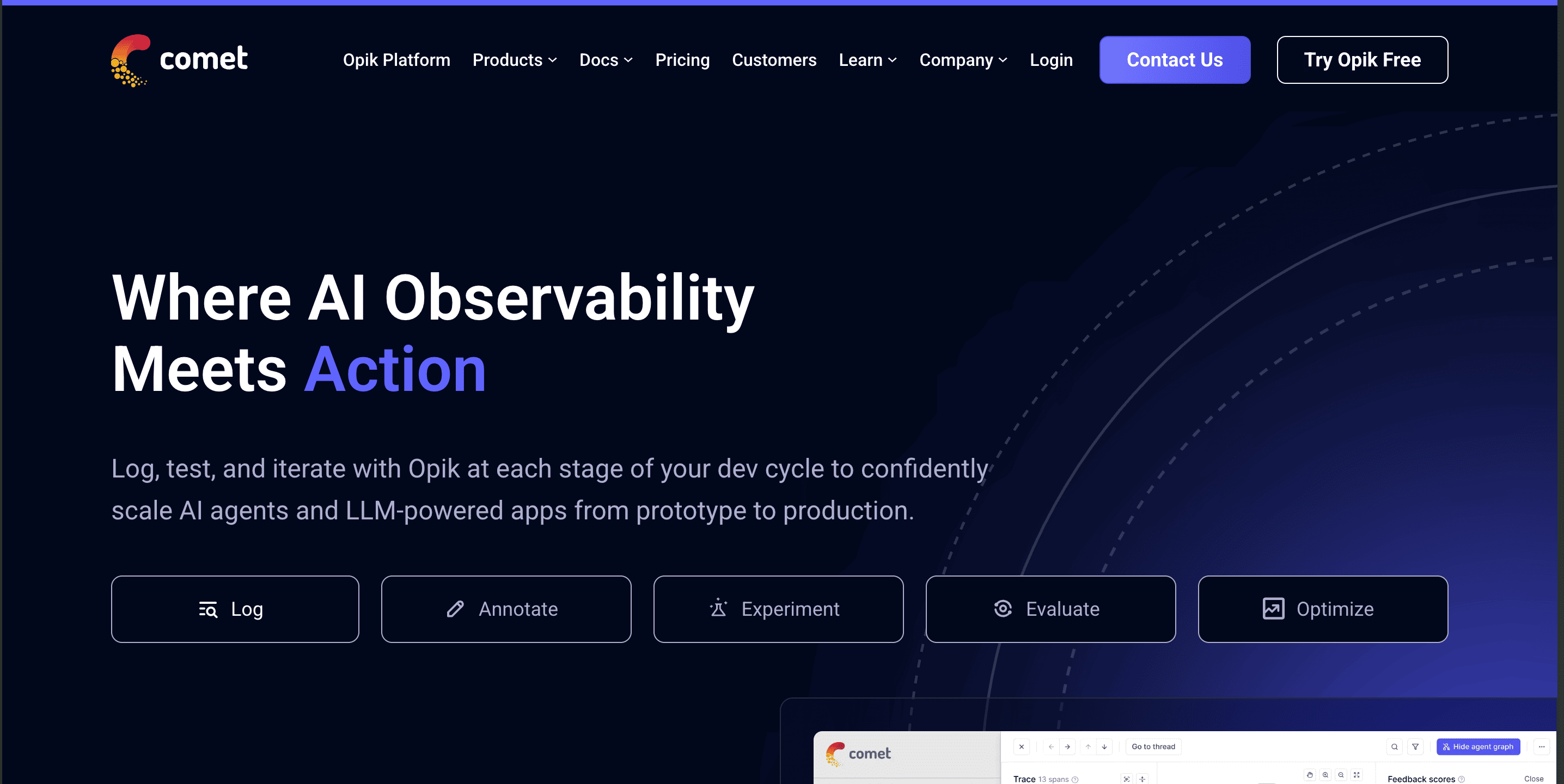
Opik (by Comet) is an open-source platform to log, view, and evaluate LLM traces in development and production. It supports LLM-as-a-Judge and heuristic evaluators, datasets for experiments, and production monitoring dashboards.
- Features:
- Experiment tracking: Log, compare, and reproduce LLM experiments at scale.
- Integrated evaluation: Supports RAG, prompt, and agentic workflows.
- Custom metrics and dashboards: Build your own evaluation pipelines.
- Collaboration: Share results, annotations, and insights across teams.
- Production monitoring with online evaluation metrics and dashboards.
- Best for:
- Data science teams that want to unify LLM evaluation with broader ML experiment tracking and governance.
- Additional sources:
- Self-hosting and Kubernetes deployment options. Self-hosting guide
Why Maxim Stands Out for AI Observability
Maxim is built for the entire AI lifecycle experiment, evaluate, observe, and curate data, so teams can scale AI reliability from pre-production and production stages. Its stateless SDKs and OpenTelemetry compatibility ensure robust tracing across services and micro-services. With online evals, multi-turn evaluations, unified metric, saved views, alerts, cross-functional collaboration, and data curation, Maxim ensures agent quality, including tools to convert logs into datasets for iterative improvement. See product pages and docs for details: Agent observability, Tracing overview, Forwarding via data connectors, Ingesting via OTLP.
For enterprise use cases, Maxim supports In-VPC deployment, SSO, RBAC, and SOC 2 Type 2. Platform overview
Which AI Observability Tool Should You Use?
- Choose Maxim if you need an integrated platform that spans simulations, evals, and observability with powerful agent tracing, online evaluations, and data curation. Maxim AI
- Choose LangSmith if your stack centers on LangChain and you want prompt iteration with unified tracing/evals. LangSmith
- Consider Arize for OTEL-based tracing, online evaluations, and comprehensive dashboards across AI/ML/CV workloads. Arize AI
- Choose Langfuse for open-source observability with flexible tracing and strong cost/latency tracking. Langfuse
- Choose Comet Opik for OSS-first teams needing tracing, evaluation, and production monitoring. Opik
Conclusion
AI agent observability in 2025 is about unifying tracing, evaluations, and monitoring to build trustworthy AI. AI observability has become essential. With LLMs, agentic workflows, and voice AI driving business processes, strong observability platforms are key to maintaining performance and user trust. Maxim AI offers the comprehensive depth, flexible tooling, and proven reliability that modern AI teams need. To deploy with confidence and accelerate iteration, consider Maxim for an end-to-end approach across the AI lifecycle. Maxim AI
Ready to evaluate and observe your agents with confidence? Book a demo or Sign up.
FAQs
- What is AI agent observability?
- Visibility into agent behavior across prompts, tool calls, retrievals, multi-turn sessions, and production performance, enabled by distributed tracing and online evaluations. Tracing overview
- How does distributed tracing help with agent debugging?
- Traces, spans, generations, and tool calls reveal execution paths, timing, errors, and results to diagnose issues quickly. Tracing concepts
- Can I use OpenTelemetry with Maxim?
- Yes. Maxim supports OTLP ingestion and forwarding to external collectors (Snowflake, New Relic, OTEL) with AI-specific semantic conventions. OTLP endpoint, Data connectors
- How do online evaluations improve AI reliability?
- Continuous scoring on real user interactions surfaces regressions early, enabling alerting and targeted remediation. Online evaluations
- Does Maxim support human-in-the-loop evaluation?
- Yes. Teams can configure human evaluations for last-mile quality checks alongside LLM-as-a-Judge and programmatic evaluators. Agent simulation & evaluation
- What KPIs should we track for agent observability?
- How do saved views help teams collaborate?
- Saved filters enable repeatable debugging workflows across teams, speeding up issue resolution. Saved views
- Can I export logs and eval data?
- Yes. Maxim supports CSV exports and APIs to download logs and associated evaluation data with filters and time ranges. Exports
- Is Maxim suitable for multi-agent and multimodal systems?
- Yes. Maxim’s tracing entities (sessions, traces, spans, generations, tool calls, retrievals, events) and attachments support complex multi-agent, multimodal workflows. Attachments
- How do alerts work in production?Further reading and resources:
- Configure threshold-based alerts on latency, cost, or evaluator scores; route notifications to Slack, PagerDuty, or OpsGenie. Set up alerts
Further Reading and Resources:
